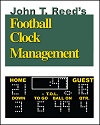Comments on 2009 Super Bowl clock management
by John T. Reed


Copyright by John T. Reed
2008 Super Bowl lost because of bad clock management
The Patriots lost the 2008 Super Bowl solely because of incorrect clock management, namely leaving too much time on the play clock again and again in the second half when they were ahead. See my analysis at http://www.johntreed.com/2008SuperBowl.html. Did the Cardinals lose the 2009 Super Bowl for clock reasons?
No. Although the Steelers in the 2009 Super Bowl did make clock-management mistakes that could have cost them the game.
Mainly, to look for clock-management errors, you look at the end of each half.
Score before halftime?
Did either team score just before halftime? Boy, did they! The Steelers’ Harrison intercepted a pass from Warner and ran it back 100 yards for a touchdown as the clock expired—a Super Bowl record.
Could the Cardinals have prevented that by following my clock-management rules? No. The pertinent rule is Chapter 7 of my book Football Clock Management which is called “Pace Graph.” The pace graphs are graphs that help a team score before the end of a half but do so without leaving any or much time on the clock for the opponent to also score before the end of the half. It’s a Goldilocks standard. You don’t want to move down the field toward the goal line too fast or too slow. You want to move down at a just-right pace. Did the Cardinals do that? Yes, although I am not sure they were thinking about it. Regardless of whether it was deliberate or accidental, they were more or less on the correct pace-graph schedule.
The Steelers’ score happened because of the turnover and lucky long run, not because of failure to adhere to the correct pace graph schedule. By the way, the Steelers were ahead during most of the first half so they should have been in a slowdown. Were they? Just glancing at the play-by-play it appears they generally were in a slowdown.
What could have been the consequence if detailed analysis shows they were not always in a slowdown during the first half after they took the lead? The Cardinals scoring a touchdown just before half, which they were highly likely to do had it not been for the pick. Any time the Steelers unnecessarily left on the game clock during the first half after they took the 3-0 lead was responsible for the Cardinals being on Pitt’s 1-yard line just before half time. Pitt is very lucky Arizona did not score a touchdown just before halftime. They would have lost the game 30-27 if the Cardinals had scored then.
Could the Cardinals have burned more time to prevent the Steelers’ game-winning TD?
When you tell me Pitt scored the winning TD with :35 left in the game, I would immediately ask, “Was Arizona ahead in the second quarter, and when they were, did they comply with my rules to take as much time off the clock as possible?”


The answer is they were ahead in the second half—after they scored their go-ahead touchdown with 2:30 left. They should have been on the pace graph for that scoring drive, which started at 2:53, and taken all that time off the clock during the drive so there would be little or no time left for Pitt to come back. Did they?
No. The drive only lasted two plays and :21: one incomplete pass at the Arizona 36 and one 64-yard touchdown pass to Fitzgerald. It’s hard to burn game-clock time (which is mainly done by staying inbounds and waiting until the end of the play clock to snap the ball) when your only plays are an incomplete pass and a touchdown.
Should Fitzgerald have run slower or taken a knee at the one, which my book advocates in some cases? No. That’s for when you only need a field goal to win or the ball carrier is way ahead of the pursuing opponents. Neither was the case here.
Steelers’ timeout could have cost them the game
A stupid timeout could have cost the Steelers the game. With 1st & goal and :49 left at the Cardinal 6-yard line, Pitt took a timeout.
What the hell for?
When you have 1st & goal, you can only run four more plays.
Can a football team run four plays in ;49? Sure. They probably don’t need to stop the clock after any of those plays. If they do, they should use the timeout on the fourth-down play, not the first down. You run the four plays with no huddle averaging about 12 second per play. If you don’t score on the first three downs, you stop the clock with :03 left and kick the field goal that puts the game into OT. Most importantly, you do not give the Cardinals any time to come back after you score.
In the event, Pitt scored a touchdown on the second-down play stopping the clock at :42. If they had not used that timeout, The Cardinals would have more like :20 for their final possession. The game would have ended when Arizona got tackled at the Pitt 44.
The Cardinals had two timeouts left on their final drive. Normally, you would think they should have used them when Pitt had the ball after Pitt got to the Arizona 6-yard line. But they had no chance to conserve game clock time after Pitt got to the AZ 6 because Pitt used one of their own timeouts immediately after arriving at the 6 and they threw incomplete on the next play, which also stopped the clock. The following play was the touchdown, which also stopped the clock.